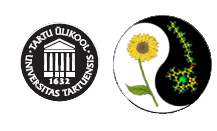For Students
Recommended introductory literature about biophysics, look also http://plantphys.ut.ee/teaching.htm
Thesis projects:
Optical spectroscopy of photosynthetic bacterium Thermochromatium tepidum
Bachelor's and/or Master's thesis
Supervisors: Margus Rätsep (margus.ratsep@ut.ee) ja Arvi Freiberg (arvi.freiberg@ut.ee)
Thermochromatium (Tch.) tepidum is a thermophilic purple bacterium that grows in the optimal temperature range of 48–50 oC. The enhanced thermal stability is attributed to the Ca2+ ions as a cofactor, present in both LH1–RC core and LH2 peripheral light harvesting antenna complexes of the bacterium. The crystal structure of the Ca2+-ion bound LH1–RC antenna complex is known at a resolution of 1.9 Å, thus allowing modeling of spectra. In the proposed work the thermal stability and optical spectra (absorption, fluorescence, circular dichroism) of LH1–RC and LH2 antenna complexes have to be studied over broad range of temperature. Additionally, high resolution fluorescence spectra at liquid He temperatures will be measured and analyzed. For students studying physics or biology.
Structure and function of biological photosynthetic systems
Bachelor's and/or Master's thesis
Supervisors: Juha Linnanto (juha.matti.linnanto@ut.ee) and Arvi Freiberg (arvi.freiberg@ut.ee)
The aim is to get acquainted with the modern quantum chemical methods and to learn how these methods can be applied for understanding photosynthetic processes. Calculations will give information on spectroscopic and energy transfer properties of photosynthetic pigment-protein complexes. Especially, the role and the nature of the lowest singlet excited states as well as charge transfer states in light-harvesting complexes will be studied. Such results are required for analyzing experimental data and for understanding the functions of photosynthetic pigment-protein complexes. The work is suitable for the students who are interested in modern computational (bio)physics and in theoretical modeling.
Effect of local enviroment on the functioning of photosynthetic antennas
Bachelor's and/or Master's thesis
Supervisors: Kõu Timpmann (kou.timpmann@ut.ee) and Arvi Freiberg (arvi.freiberg@ut.ee)
A functional role of light harvesting antennas in photosynthesis is the absorption of the solar energy and excitation transfer to the photochemical reaction centers. In natural conditions the protein-chlorophyll complexes exist in a water environment. However, advanced probing (for example, by single molecule spectroscopy) of the functioning of light harvesting antennas requires the replacement of water environment with polymer environment. In the proposed experimental study the mechanism of light harvesting in antennas embedded in a polymer matrix will be studied using various methods of laser spectroscopy.
Time-resolved spectroscopy of mutated reaction centers
Bachelor's and/or Master's thesis
Supervisors: Kõu Timpmann (kou.timpmann@ut.ee) and Arvi Freiberg (arvi.freiberg@ut.ee)
In a bacterial photosynthesis the energy of the absorbed light is converted to the energy of separated charges in molecular complexes called reaction centers. The charge separation dynamics is an ultrafast process occurring in ps/fs time scale. An comparative experimental investigation of the charge separation dynamics in bacterial reaction centers with controlled genetic mutations by using ultrafast time-resolved spectroscopy is proposed.
Biomolecular interactions under high pressure
Bachelor's and/or Master's thesis
Supervisors: Liina Kangur (liina.kangur@ut.ee) and Arvi Freiberg (arvi.freiberg@ut.ee)
Our environment affects our behavior. This well-known statement holds also in microworld at atomic/molecular level. High external pressure shifts atoms/molecules closer to each other and thereby changes their intermolecular interactions. As a result the characteristic spectra of the sample will change, through which we can learn about these interactions. At a bachelor level a student becomes acquainted with the high pressure equipment (the design of an optical high-pressure cell, the techniques of measuring pressures in the order of 10 kbar), simpler spectral measurements (absorption and emission spectra), data analysis (using Origin and Mathcad) and preparing the thesis. At master of doctoral level the spectral peculiarities of biomolecules (phthalocyanines, porphyrins, chlorophyll, bacteriochlorophyll, e.t.c.) and their aggregates at high pressure will be studied. A detailed knowledge of the mechanisms of shaping and fine-tuning the spectra of molecular aggregates leads to a better understanding how the photosynthetic organisms harvest solar energy and how they adjust to the extreme environmental conditions. Such a study might give ideas for developing the future-oriented biomimetic energy projects, that replace currently used expensive environment-burdening technologies. This experimental work is suitable for students specialized in applied physics, materials science, infotechnology or environmental technology.
Structure and dynamics of membrane proteins studied by fluorescence spectroscopy
Bachelor's and/or Master's thesis
Supervisors: Liina Kangur (liina.kangur@ut.ee) and Arvi Freiberg (arvi.freiberg@ut.ee)
30-40% of all proteins are membrane proteins. Investigation of their structural properties compared to water-soluble proteins is troublesome. Here we make use of the circumstance, that main amino acids contributing to the protein self-emission (Trp, Tyr ja Phe) prefer to gather in regions, close to the boundary layers separating the lipid membrane from the water environment. Especially Trp reacts very sensitively to the changes in the protein surrounding environment (the solvent polarity, for example). Therefore the changes in the shape of Trp spectrum and in the Trp emission lifetime as a function of external pressure can give valuable information about the conformational changes and their dynamics in protein. The work is suitable for every successful natural science student. All the special knowledge for this work will be acquired on site. There are problems to solve for a MSc thesis as well as for a PhD thesis for every student, who have serious interest.
